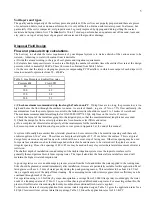
6
Table 3.1 *
Commonly used spacing
Water application rate using 4.0 l/hr Classic dripper mm/m2/hr
Dripper
Dripline Lateral Spacing (cm)
Spacing cm
30
40
50
60
75
100
150
60
22.2 16.7 13.3
*11.1
8.9 *6.7 4.4
Table 3.2 *
Commonly used spacing
Water application rate using 2.4 l/hr PC dripper mm/m2/hr
Dripper
Dripline Lateral Spacing (cm)
Spacing cm
30
40
50
60
75
100
150
60 13.3
10.0
8.0
*6.7
5.3 *4.0 2.7
Calculation Example (Note: Triangle has a spread sheet calc’s available)
A 3000 LPD system Is to be designed. The system is to be located on a tight heavy natural clay loam soil with
an estimated saturated hydraulic conductivity of 2.5 mm/hr. The long term acceptable application rate is
5 mm/m2/day. (Note: Turf grass will be grown on the site with a peak evapotranspiration of 10.5 mm per day.
The site is all level, so in actual fact in summer deficit irrigation will occur).
a) Field area required =
3000/5 = 600 m2
b) Emitter line spacing = 60 cm (0.6 m) Emitter line required = 600/0.6 = 1000 m
c) Emitter spacing = 60 cm (0.6 m)
d) Total number emitters = 1000/0.6 = 1667 emitters
e) Emitter flow rate = 4.0 LPH @ 100 kPa
f) Total flow = 1667 x 4.0 LPH = 6668 LPH
g) Daily irrigation time = 3000 l/day / 6668 LPH = 0.45 hours/ day = 27.0 minutes
h) Pumping rate required = 6668 LPH, or 111 LPM, or 1.85 LPSEC
i) System operating pressure = 100 kPa (15 psi).
j) If a 750 litre dosing volume were used for an average flow of 3000 litres per day, about 4 irrigation cycles per
day would be made, lasting about 6.8 minutes each.
k) In many cases it may be more convenient to have two (2) or more smaller irrigation stations instead of one
single large one. This would be done by dividing the total disposal field into the number of sectors required.
These can be controlled with the use of a Waterotor Valve, solenoid valves and controllers
Example:
The above disposal field could be run in two (2) sectors each controlled by a solenoid valve. This would reduce
the flow rate proportionally be 1/2 to 7167 L/HR/2 = 3584 l/hr. With the control system sending water to
alternate sectors when the pump starts up.
Design & Installation Considerations
Distance from edges.
Allow not more than 6 inches from the edges, particularly if it is the top edge of a slope. Edges tend to dry more easily
than the center. Remember that at the bottom of a slope the distance from the edges may be larger. On turf add extra lines
along the edge parallel to the flush and header line, i.e. at right angles to the other dripperlines. These extra lines can be
coupled into the flush and header line with compression fittings.
Wind.
If there is a prevailing summer wind direction turf may brown at the edge facing the wind. Place the first dripperline as
close to the edge as practical and add an extra dripperline 15 cm from the first line.












